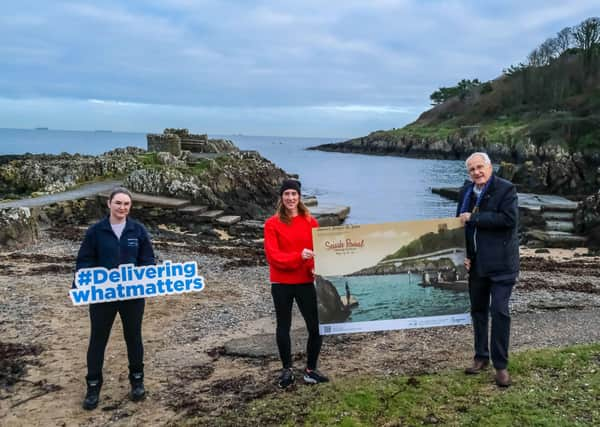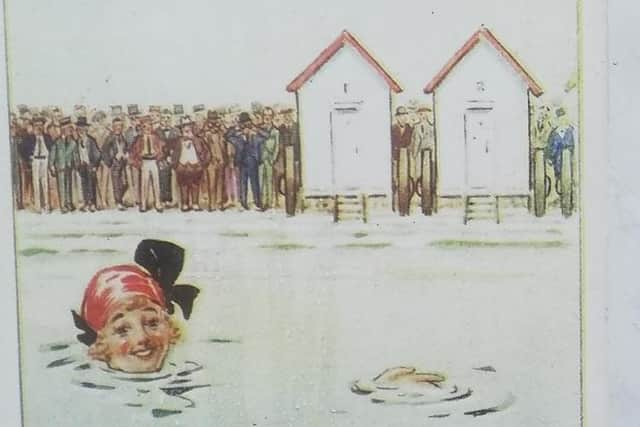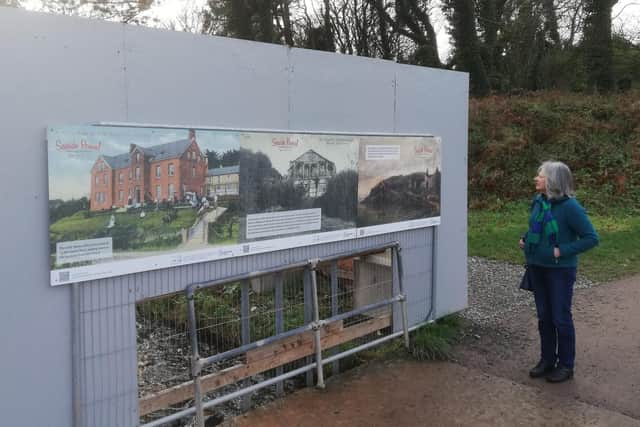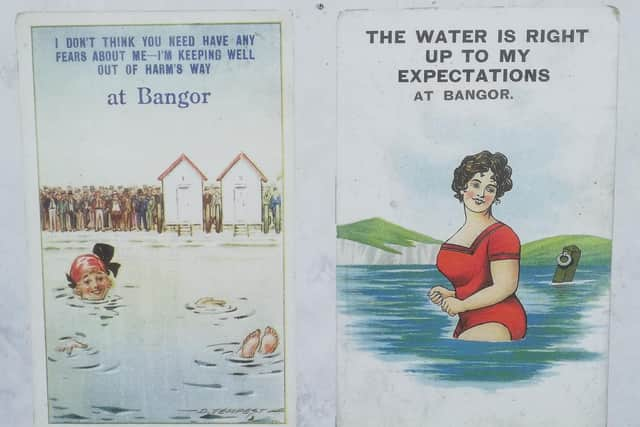Local history on the hoardings along popular coastal walkway


They’ll replace the old, outdated infrastructure, at the popular and picturesque Brompton Road and Stricklands Glen locations.
The construction of pumping stations nowadays wouldn’t automatically be considered to have creative potential but a unique collaboration between Bangor’s Seaside Revival Vintage festival, some local historians and NI Water, has proved otherwise.
Advertisement
Hide AdAdvertisement
Hide AdThe NI Water construction project, which is part of a £4m investment to upgrade the local sewerage infrastructure and help improve water quality along the North Down coast, has required the erection of large hoardings at both construction sites for health and safety purposes.


Recognising the value of these hoardings as a blank canvas in this area of outstanding natural beauty, Seaside Revival got together with local historians and NI Water to create an exclusive exhibition of old photographs and postcards which will adorn the hoardings for the remainder of the construction works.
Each image is of historical significance to the area and has been meticulously researched by dedicated local historian Robin Masefield with contributions from Betty Armstrong, Ian Wilson and North Down Museum.
“This is such a wonderful scheme to be involved with,” Seaside Revival co-ordinator Caroline McCoubrey explained, adding “It perfectly embodies the Seaside Revival ethos of connecting people to their past while building a future together. In a time of great turbulence when so many of our activities and events have been cancelled, these prints will be both a welcome talking point, and a creative stimulus for the people of Bangor.”
Advertisement
Hide AdAdvertisement
Hide AdLocal historian Robin Masefield, who often contributes to Roamer’s page, was the inspiration behind the project.


While out walking at the early building phase of the pumping stations, it occurred to him that there must be a way to decorate the hoardings with local historical content.
He spoke to the contractors on site who in turn spoke with NI Water, who agreed to consider a proposal.
Robin then approached Caroline to see if Seaside Revival would be interested in co-ordinating the initiative.
Advertisement
Hide AdAdvertisement
Hide Ad“I am thrilled both with the positive response of NI Water and the creative energy of the Seaside Revival team and fellow contributors,” Robin told me.


He explained that the project has “brought to life aspects of the past which have real local significance and which we believe the walking public will find fascinating. We hope this may be a model for elsewhere too.”
Eleven images were selected for the hoardings, six of which are on display at Brompton and five at Stricklands Glen. Some are relatively familiar, like the Ladies Diving Board at Skippingstone, and Jenny Watt’s Cove.
Others may be less well known, including the old Malayan style Bungalow Tea House at Stricklands Glen, the Girl’s Home of Rest at Brompton, and former all-Ireland diving champion and first ever Ladies Captain at Carnalea Golf Club, Marguerite Absolum McMurry.
Advertisement
Hide AdAdvertisement
Hide AdThere are also historic images of the home green at Royal Belfast (now Carnalea) Golf Club, Smelt Mill Bay, and Carnalea Railway Station.
Each of the A0 size boards (841 by 1189 mm, or 33.1 by 46.8 inches) has a QR (quick response) code which, when scanned on a smart phone, immediately takes the viewer to the Seaside Revival website where they can read the story behind the image.
For instance, the history of Stricklands Glen on the website, compiled by Bangor Historical Society’s Ian Wilson, goes back to 1789 when Robert Ward granted a lease for life to John Strickland of land already in his possession: eight acres at Bryansburn with a flax mill on it (the 1858 Ordnance Survey map shows an old flax mill south of Bryansburn Bridge).
The lease stated that the eight acres didn’t include the road leading to the smelt mill and just over an acre of land around the mill.
Advertisement
Hide AdAdvertisement
Hide AdThis, it is assumed, is the origin of the name Strickland’s. When Bangor Urban District Council bought the glen from Col. Sharman-Crawford in 1913, they laid out the paths and bridges which are still there today.
Welcoming the opportunity to support the innovative scheme, Catherine Watkins, NI Water Project Manager for the hoardings endeavour said: “NI Water appreciates the long-running association with sea swimming in the Brompton area and is delighted to support Seaside Revival’s initiative and have these fabulous history boards adorn our site hoardings. The investment being undertaken at Brompton Road and Stricklands Glen is part of a wider NI Water commitment to improving bathing water quality right along the North Down coast. The modern infrastructure being installed in this multi-million-pound project will help ensure that open-air swimming can be enjoyed by generations to come.”
Information on the extensive work being carried out at Brompton Road and Stricklands Glen and the environmental benefits it will deliver to the local community can be viewed alongside the history boards.
The historic photographs and images will remain on the hoardings for the duration of the construction.
Advertisement
Hide AdAdvertisement
Hide AdOrganised by Open House Festival and funded by The National Lottery Heritage Fund’s Great Place Scheme, Seaside Revival is a celebration of all things vintage, local and seaside-inspired and aims to re-position Bangor as a modern seaside town while paying tribute to its rich cultural past.
You can check out the website at www.openhousefestival.com/seaside-revival/niwaterproject/